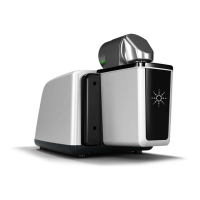Getting Started
20 Agilent Cary 630 FTIR Spectrometer User’s Guide
Validation
The MicroLab PC software has three tests appropriate for
performance validation of the Cary 630 FTIR. Performance validation
verifies the key aspects of the instrument’s ability to measure good
data. If the performance validation tests are within specification, the
spectrometer should provide data that works well with methods
developed for the Cary 630. As with any instrument, however, results
can always be verified by running a known sample with the sample-
specific method.
The validation tests are accessed from the Advanced Features, System
Check page of the MicroLab PC software. The Cary 630 FTIR system
should be warmed up for at least 120 minutes before conducting any
of these tests.
Performance (signal-to-noise) test
This test measures the signal-to-noise level at two regions of the
infrared spectrum: 2,500 cm
-1
and 1,000 cm
-1
. Both the background
and sample are measured at 4 cm
-1
resolution with a one minute
collection time. This test takes two minutes per test. You can specify a
number of tests to be conducted. For diffuse reflectance
measurements, the appropriate sample position must be in place with
the diffuse gold mirror. No sample is needed when using the Diamond
ATR sampling accessory. At least 10 tests should be collected in order
to obtain an accurate picture of the performance.
Stability test
This test measures the short-term stability at two regions of the
spectrum: 3,000 cm
-1
and 1,000 cm
-1
. Stability is a measurement of the
baseline differences observed over the selected time period. The test
measures a background at the beginning, then one sample every
minute for the duration of the test as specified in the ‘Number of
minutes’ field in the software. For diffuse reflectance measurements,
the appropriate sample position must be in place with the diffuse gold
mirror. No sample is needed when using the Diamond ATR sampling
accessory. The test results are expressed as %Transmittance
(difference versus 100%) of maximum deviation during the Stability
test.

